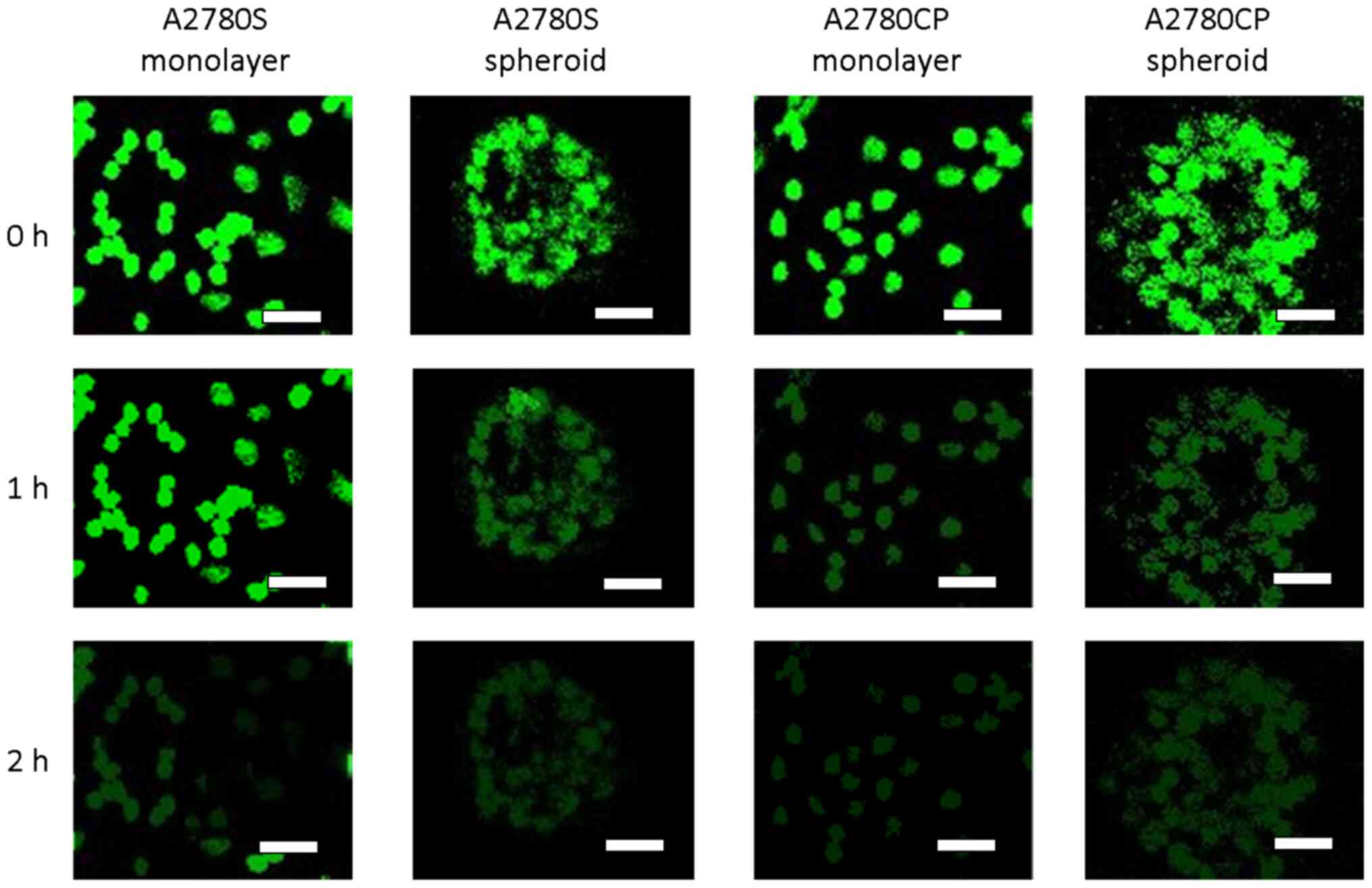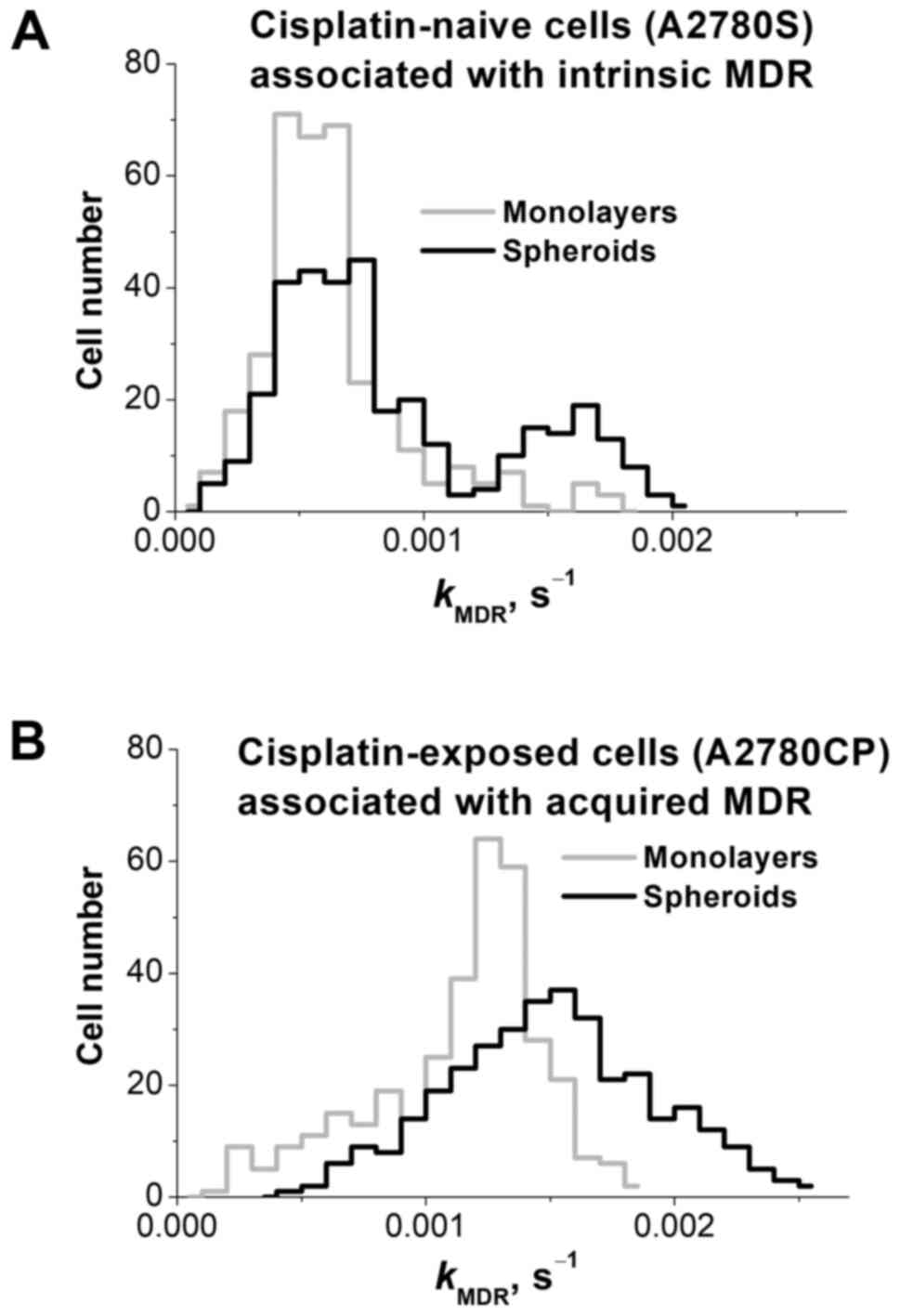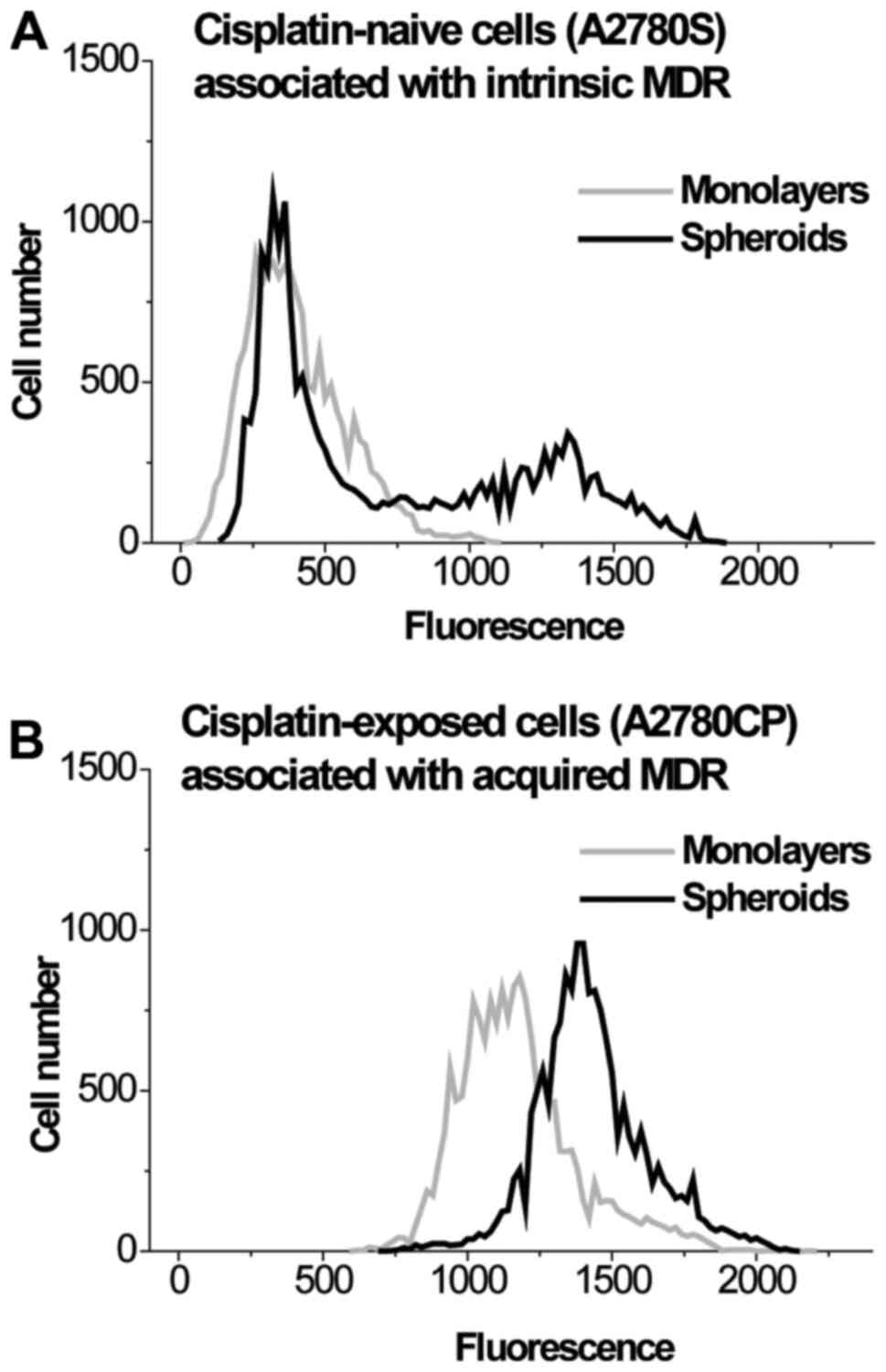|
1
|
Rueff J and Rodrigues AS: Cancer drug
resistance: A brief overview from a genetic viewpoint. Methods Mol
Biol. 1395:1–18. 2016.PubMed/NCBI View Article : Google Scholar
|
|
2
|
Norouzi-Barough L, Sarookhani MR, Sharifi
M, Moghbelinejad S, Jangjoo S and Salehi R: Molecular mechanisms of
drug resistance in ovarian cancer. J Cell Physiol. 233:4546–4562.
2018.PubMed/NCBI View Article : Google Scholar
|
|
3
|
Srivastava R, Srivastava A and Chochung Y:
Multidrug resistance in cancer (review). Int J Oncol. 9:879–884.
1996.PubMed/NCBI View Article : Google Scholar
|
|
4
|
Zhang Y, Sriraman S, Kenny H, Luther E,
Torchilin V and Lengyel E: Reversal of chemoresistance in ovarian
cancer by co-delivery of a P-glycoprotein inhibitor and paclitaxel
in a liposomal platform. Mol Cancer Ther. 15:2282–2293.
2016.PubMed/NCBI View Article : Google Scholar
|
|
5
|
Hwang WL, Hwang KL and Miyamoto DT: The
promise of circulating tumor cells for precision cancer therapy.
Biomark Med. 10:1269–1285. 2016.PubMed/NCBI View Article : Google Scholar
|
|
6
|
Guiliano M, Shaikh A, Lo HC, Arpino G, De
Placido S, Zhang XH, Cristofanilli M, Shiff R and Trivedi MV:
Perspective on circulating tumor cell clusters: Why it takes a
village to metastasize. Mol Cancer Res. 78:845–852. 2018.PubMed/NCBI View Article : Google Scholar
|
|
7
|
Lee M, Kim EJ, Cho Y, Kim S, Chung HH,
Park NH and Song YS: Predictive value of circulating tumor cells
(CTCs) captured by microfluidic device in patients with epithelial
ovarian cancer. Gynecol Oncol. 145:361–365. 2017.PubMed/NCBI View Article : Google Scholar
|
|
8
|
Koshkin V, Kochmann S, Sorupanathan A,
Peng C, Ailles LE, Liu G and Krylov SN: Cytometry of reaction rate
constant: Measuring reaction rate constant in individual cells to
facilitate robust and accurate analysis of cell-population
heterogeneity. Anal Chem. 91:4186–4194. 2019.PubMed/NCBI View Article : Google Scholar
|
|
9
|
Koshkin V, Bleker de Oliveira M, Peng C,
Ailles LE, Liu G, Covens A and Krylov SN: Spheroid-based approach
to assess the tissue relevance of analysis of dispersed-settled
tissue cells by cytometry of the reaction rate constant. Anal Chem.
92:9348–9355. 2020.PubMed/NCBI View Article : Google Scholar
|
|
10
|
Durand RE: Flow cytometry studies of
intracellular adriamycin in multicell spheroids in vitro. Cancer
Res. 41:3495–3498. 1981.PubMed/NCBI
|
|
11
|
Xu G, Zhong Y, Munir S, Yang BB, Tsang BK
and Peng C: Nodal induces apoptosis and inhibits proliferation in
human epithelial ovarian cancer cells via activin receptor-like
kinase 7. J Clin Endocrinol Metab. 89:5523–5534. 2004.PubMed/NCBI View Article : Google Scholar
|
|
12
|
Sasaki H, Sheng Y, Kotsuji F and Tsang BK:
Down-regulation of X-linked inhibitor of apoptosis protein induces
apoptosis in chemoresistant human ovarian cancer cells. Cancer Res.
60:5659–5666. 2000.PubMed/NCBI
|
|
13
|
Jendželovská Z, Jendželovský R, Hiľovská
L, Kovaľ J, Mikeš J and Fedoročko P: Single pre-treatment with
hypericin, a St. John's wort secondary metabolite, attenuates
cisplatin- and mitoxantrone-induced cell death in A2780, A2780cis
and HL-60 cells. Toxicol In Vitro. 28:1259–1273. 2014.PubMed/NCBI View Article : Google Scholar
|
|
14
|
Raghavan S, Ward MR, Rowley KR, Wold RM,
Takayama S, Buckanovich RJ and Mehta G: Formation of stable small
cell number three-dimensional ovarian cancer spheroids using
hanging drop arrays for preclinical drug sensitivity assays.
Gynecol Oncol. 138:181–189. 2015.PubMed/NCBI View Article : Google Scholar
|
|
15
|
Ween MP, Armstrong MA, Oehler MK and
Ricciardelli C: The role of ABC transporters in ovarian cancer
progression and chemoresistance. Crit Rev Oncol Hematol.
96:220–256. 2015.PubMed/NCBI View Article : Google Scholar
|
|
16
|
Cunnea P and Stronach EA: Modeling
platinum sensitive and resistant high-grade serous ovarian cancer:
Development and applications of experimental systems. Front Oncol.
4(81)2014.PubMed/NCBI View Article : Google Scholar
|
|
17
|
Li N, Zuo H, Chen L, Liu H, Zhou J, Yao Y,
Xu B, Gong H, Weng Y, Hu Q, et al: Circfulating tumor cell
detection in epithelial ovarian cancer using dual-component
antibodies targeting EpCAM and FRα. Cancer Manag Res.
11:109939–10948. 2019.PubMed/NCBI View Article : Google Scholar
|
|
18
|
Mahdizadeh S, Karimi G, Behravan J,
Arabzadeh S, Lage H and Kalalinia F: Crocin suppresses multidrug
resistance in MRP overexpressing ovarian cancer cell line. Daru.
24(17)2016.PubMed/NCBI View Article : Google Scholar
|
|
19
|
Friedrich J, Seidel C, Ebner R and
Kunz-Schughart LA: Spheroid-based drug screen: Considerations and
practical approach. Nat Protoc. 4:309–324. 2009.PubMed/NCBI View Article : Google Scholar
|
|
20
|
Frankel A, Buckman R and Kerbel RS:
Abrogation of taxol-induced G2-M arrest and apoptosis in human
ovarian cancer cells grown as multicellular tumor spheroids. Cancer
Res. 57:2388–2393. 1997.PubMed/NCBI
|
|
21
|
Acker H, Carlsson J, Holtermann G,
Nederman T and Nylén T: Influence of glucose and buffer capacity in
the culture medium on growth and pH in spheroids of human thyroid
carcinoma and human glioma origin. Cancer Res. 47:3504–3508.
1987.PubMed/NCBI
|
|
22
|
Morrow CS, Peklak-Scott C, Bishwokarma B,
Kute TE, Smitherman PK and Townsend AJ: Multidrug resistance
protein 1 (MRP1, ABCC1) mediates resistance to mitoxantrone via
glutathione-dependent drug efflux. Mol Pharmacol. 69:1499–1505.
2006.PubMed/NCBI View Article : Google Scholar
|
|
23
|
Nakano A, Tsuji D, Miki H, Cui Q, El Sayed
SM, Ikegame A, Oda A, Amou H, Nakamura S, Harada T, et al:
Glycolysis inhibition inactivates ABC transporters to restore drug
sensitivity in malignant cells. PLoS One. 6(e27222)2011.PubMed/NCBI View Article : Google Scholar
|
|
24
|
Teng YN, Hsieh YW, Hung CC and Lin HY:
Demethoxycurcumin modulates human P-glycoprotein function via
uncompetitive inhibition of ATPase hydrolysis activity. J Agric
Food Chem. 63:847–855. 2015.PubMed/NCBI View Article : Google Scholar
|
|
25
|
Ham SL, Joshi R, Thakuri PS and Tavana H:
Liquid-based three-dimensional tumor models for cancer research and
drug discovery. Exp Biol Med (Maywood). 241:939–954.
2016.PubMed/NCBI View Article : Google Scholar
|
|
26
|
Szakács G, Annereau JP, Lababidi S,
Shankawaram U, Arciello A, Bussey KJ, Reinhold W, Guo Y, Kruh GD,
Reimers M, et al: Predicting drug sensitivity and resistance:
Profiling ABC transporter genes in cancer cells. Cancer Cell.
6:129–137. 2004.PubMed/NCBI View Article : Google Scholar
|
|
27
|
Howard GR, Johnson KE, Rodriguez Ayala A,
Yankeelov TE and Brock A: A multi-state model of chemoresistance to
characterize phenotypic dynamics in breast cancer. Sci Rep.
8(12058)2018.PubMed/NCBI View Article : Google Scholar
|
|
28
|
Sun FF, Hu YH, Xiong LP, Tu XY, Zhao JH,
Chen SS, Song J and Ye XQ: Enhanced expression of stem cell markers
and drug resistance in sphere-forming non-small cell lung cancer
cells. Int J Clin Exp Pathol. 8:6287–6300. 2015.PubMed/NCBI
|
|
29
|
He M, Wu H, Jiang Q, Liu Y, Han Li, Yan Y,
Wei B, Liu F, Deng X, Chen H, et al: Hypoxia-inducible factor-2α
directly promotes BCRP expression and mediates the resistance of
ovarian cancer stem cells to adriamycin. Mol Oncol. 13:403–421.
2019.PubMed/NCBI View Article : Google Scholar
|
|
30
|
Hallas-Potts A, Dawson JC and Herrington
CS: Ovarian cancer cell lines derived from non-serous carcinomas
migrate and invade more aggressively than those derived from
high-grade serous carcinomas. Sci Rep. 9(5515)2019.PubMed/NCBI View Article : Google Scholar
|
|
31
|
Partin AW, Schoeniger JS, Mohler JL and
Coffey DS: Fourier analysis of cell motility: Correlation of
motility with metastatic potential. Proc Natl Acad Sci USA.
86:1254–1258. 1989.PubMed/NCBI View Article : Google Scholar
|
|
32
|
Galarza S, Kim H, Atay N, Peyton SR and
Munson JM: 2D or 3D? How cell motility measurements are conserved
across dimensions in vitro and translate in vivo. Bioeng Transl
Med. 5(e10148)2019.PubMed/NCBI View Article : Google Scholar
|
|
33
|
Luzhansky ID, Schwartz AD, Cohen JD,
MacMunn JP, Barney LE, Jansen LE and Peyton SR: Anomalously
diffusing and persistently migrating cells in 2 and 3D culture
environments. APL Bioeng. 2(026112)2018.PubMed/NCBI View Article : Google Scholar
|
|
34
|
Raghavan S, Mehta P, Horst EN, Ward MR,
Rowley KR and Mehta G: Comparative analysis of tumor spheroid
generation techniques for differential in vitro drug toxicity.
Oncotarget. 7:16948–16961. 2016.PubMed/NCBI View Article : Google Scholar
|


















